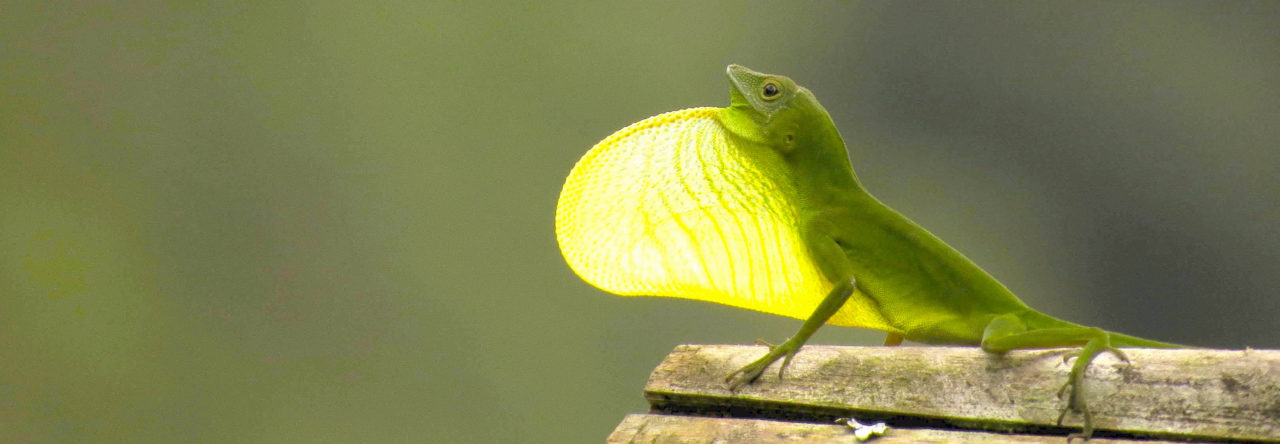
Rachana applying fluorescent powder to a wild brown anole
This post is an update of one from 2020. Below is the old post based on a presentation by Rachana Bhave at the 2020 SICB meetings. Rachana has now done the genetic parentage studies and published the cool paper in Behavioral Ecology. Here’s the abstract of the paper:
In promiscuous species, fitness estimates obtained from genetic parentage may often reflect both pre- and post-copulatory components of sexual selection. Directly observing copulations can help isolate the role of pre-copulatory selection, but such behavioral data are difficult to obtain in the wild and may also overlook post-copulatory factors that alter the relationship between mating success and reproductive success. To overcome these limitations, we combined genetic parentage analysis with behavioral estimates of sizespecific mating in a wild population of brown anole lizards (Anolis sagrei). Males of this species are twice as large as females and multiple mating among females is common, suggesting the scope for both pre- and post-copulatory processes to shape sexual selection on male body size. Our genetic estimates of reproductive success revealed strong positive directional selection for male size, which was also strongly associated with the number of mates inferred from parentage. In contrast, a male’s size was not associated with the fecundity of his mates or his competitive fertilization success. By simultaneously tracking copulations in the wild via the transfer of colored powder to females by males from different size quartiles, we independently confirmed that large males were more likely to mate than small males. We conclude that body size is primarily under pre-copulatory sexual selection in brown anoles, and that postcopulatory processes do not substantially alter the strength of this selection. Our study also illustrates the utility of combining both behavioral and genetic methods to estimate mating success to disentangle pre- and post-copulatory processes in promiscuous species.
And here’s the post from 2020:
If you’ve ever tried to note how often lizards mate, you’ve likely found yourself staring at an individual for hours at a time, sometimes with little to no movement at all, let alone observing copulations! Further, if you’re unable to catch the animal after your behavioral observations, you may not be able to draw any conclusions about traits that influence how successful an individual is at mating with another.
Rachana Bhave, a fourth year PhD candidate in Bob Cox’s lab at University of Virginia, studies pre- and post-copulatory sexual selection in brown anoles (Anolis sagrei). One of her interests includes estimating mating rates in the wild and, in particular, testing if traits such as body size directly influence these rates. Given the power required to detect selection statistically, using simple behavioral observations can be inefficient. Further, because selection is a measure of covariance between phenotype and fitness, one needs phenotypic values for each individual within her analyses. Thankfully, Rachana was able to come up with a robust technique to estimate mating rates using an island population of brown anoles in Florida: fluorescent powders!
To understand how size affects mating rate in the brown anole, Rachana and colleagues caught 153 adult male lizards in May and 128 adult male lizards in July, weighed them, and then assigned them to one of four fluorescent powder treatments. Each mass quartile was painted with a unique color of fluorescent powder on their cloaca and released to their initial capture location. After two days, all females on the island were captured and their cloaca were examined under UV light to look for the presence and color of fluorescent powder, which would suggest that she mated with a painted male. Using this technique, Rachana found that within two days, 24% of the captured females had mated in May and 48% had mated in July. These rates were shockingly high for such a short time frame!

A) Powdering an adult male brown anole; B) copulating brown anoles; C) powder visible on the cloaca of a female brown anole, evidence of copulation
Images from Rachana’s poster
Further, she found that both larger males and larger females mated significantly more than smaller males and females across the two sampling periods. Interestingly, 2% of females had multiple colors on their cloacas, which suggests they mated multiple times with males from different size classes in the two-day span. Because multiple matings within the same size class would be undetectable, this is likely an underestimation of multiple matings in the wild.
Next, Rachana plans to quantify male reproductive success using genetic parentage analysis to begin to tease apart how pre- and post-copulatory selection influences selection. We are all looking forward to her results next year! Meanwhile, you can take a look at her poster to find out more on her website.
- Evolution in Real Time on Lizard Island - March 23, 2025
- Spider Snags Adult Anolis osa - March 22, 2025
- An Homage to the Green Anoles of New Orleans - March 21, 2025


Leave a Reply